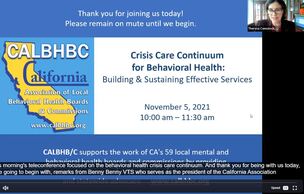Crisis Care Continuum
Program Examples
|
|
Reports / Resources / ArticlesCalHHS Crisis Care Continuum Plan (August 2023): The CCC-P identifies the statewide vision for a full continuum of services for individuals experiencing behavioral health crises, articulates statewide minimum standards and metrics, and defines models and prototypes of how statewide services could be implemented locally, recognizing the need for creative approaches for California’s diverse communities. Crisis Care Continuum Plan, 988/CCC-P website
Medi-Cal Mobile Crisis Services Benefit Implementation. In October 2022, DHCS submitted to the Centers for Medicare and Medicaid Services (CMS) State Plan Amendment (SPA) 22-0043 that establishes mobile crisis services as a new benefit in the Medi-Cal program. Medi-Cal behavioral health delivery systems may begin implementing the mobile crisis services benefit as soon as January 1, 2023, and shall have the benefit fully implemented by December 31, 2023. DHCS Mobile Crisis Fact Sheet Ensuring Coverage of Behavioral Health Emergency Services, The Kennedy Forum, 2022 Assessing the Continuum of Care for Behavioral Health Services in California, CA DHCS 2022 Mobile Crisis MediCal Funding
Contra Costa's new A3 crisis unit helps prioritize mental health call response, 2022 String of LAPD Shootings Exposes LA's Broken Mental Health System, Officials Say, LA Times, November 18, 2021 Expanding Alternative Crisis Response in Los Angeles County (Item 6, Agenda of June 8, 2021) Motion Report Response Settlement Reached Between Disability Rights California and San Benito County to Improve the County’s Behavioral Health System, April 2021 CA Dedicates $20 Million to Support New Mental Health "988" crisis line, CA Department of Health Care Services, September 2021 Roadmap to the Ideal Crisis System: Essential Elements, Measurable Standards, and Best Practice for Behavioral Health Crisis Response. The National Council for Behavioral Health, 2021 Peer Respites Provide an Alternative to Psychiatric Wards During Pandemic, Kaiser Health News National Guidelines for Behavioral Health Crisis Care - Best Practice Toolkit Executive Summary (PDF | 1 MB) Best Practice Toolkit (PDF | 2 MB) Crisis Services: Effectiveness, Cost Effectiveness, and Funding Strategies, SAMHSA 2014 Plan for Crisis and Other Safety Net Services in the California Developmental Services System: CA Health & Human Services 2017 |
Cost SavingsGRAND MENTAL HEALTH "Since introducing the model, outcomes have been staggering: Inpatient hospitalizations among GRAND adult clients at an Oklahoma psychiatric hospital were reduced by 93.1 percent. From 2016 to 2021, this reduction saved more than $62 million. The number of adult clients served increased by 163.5 percent. And law enforcement in seven counties saved both 576 days in time spent transporting clients and over $718,000 from reductions in time and distance spent transporting clients." The Philadelphia Citizen
CAHOOTS (Crisis Assistance Helping Out On The Streets), mobile crisis intervention program in Eugene, OR - CAHOOTS, is estimated to save the city $8,500,000 in public safety spending annually. In 2019, Eugene’s CAHOOTS team answered 17 percent of the police department’s overall call volume. Out of 24,000 calls, police backup was requested only 150 times. Crisis Now - A crisis continuum program model implemented in Phoenix, Arizona, Crisis Now, is estimated to have reduced inpatient spending by $260,000,000, preventing $37,000,000 in costs to hospital emergency departments in 2016. Phoenix saved the equivalent of 37 full-time police officers and further reduced city fire department costs. |


